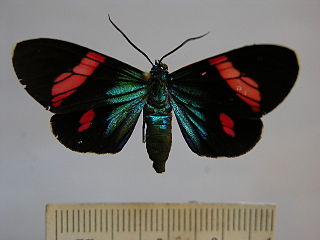Epimolis is a genus of moths in the family Erebidae. The genus was erected by Harrison Gray Dyar Jr. in 1913.

Heliactinidia is a genus of moths in the subfamily Arctiinae. The genus was erected by George Hampson in 1901.
Zatrephes is a genus of moths in the family Erebidae. The genus was erected by Jacob Hübner in 1819. It was formerly considered part of the Arctiidae. It includes the former genus Ennomomima, which is now considered a synonym.
Epimolis creon is a moth of the family Erebidae. It was described by Herbert Druce in 1897. It is found in Mexico.
Epimolis zatrephica is a moth of the family Erebidae. It was described by Harrison Gray Dyar Jr. in 1913. It is found in Mexico.
Eupyra imperialis is a moth of the subfamily Arctiinae. It was described by Gottlieb August Wilhelm Herrich-Schäffer in 1853. It is found in Venezuela, Peru and Colombia.
Epimolis affinis is a moth of the family Erebidae. It was described by Walter Rothschild in 1909. It is found in French Guiana, Venezuela and Peru.
Epimolis arcifera is a moth of the family Erebidae. It was described by Paul Dognin in 1912. It is found in Colombia.
Epimolis conifera is a moth of the family Erebidae. It was described by Paul Dognin in 1912. It is found in Colombia.
Epimolis flavonotata is a moth of the family Erebidae. It was described by Walter Rothschild in 1909. It is found in French Guiana, the Amazon region and Venezuela.

Epimolis incarnata is a moth of the family Erebidae. It was described by George Hampson in 1901. It is found in French Guiana, Brazil, Ecuador and Peru.

Pseudepimolis incisa is a moth of the family Erebidae. It was described by Walter Rothschild in 1909. It is found in Costa Rica, French Guiana, Brazil, the upper Amazon region, Venezuela and Bolivia.
Epimolis pseudopraemolis is a moth of the family Erebidae. It was described by Walter Rothschild in 1909. It is found in Peru.
Epimolis syrissa is a moth of the family Erebidae. It was described by Herbert Druce in 1906. It is found in Peru.
Halysidota atra is a moth of the family Erebidae. It was described by Herbert Druce in 1884. It is found in Guatemala, Mexico, Honduras, Costa Rica, Nicaragua, Panama, Peru, Colombia, Ecuador and Bolivia.

Hypocrita glauca is a moth of the family Erebidae. It was described by Pieter Cramer in 1777. It is found in Suriname, Colombia, Brazil and Peru.

Hypomolis aeruginosa is a moth of the family Erebidae. It was described by Felder and Rogenhofer in 1874. It is found in Colombia and Peru.
Hypomolis sanguinipectus is a moth of the family Erebidae. It was described by Adalbert Seitz in 1919. It is found in Colombia and Peru.
Lepidokirbyia vittipes is a moth of the family Erebidae first described by Francis Walker in 1855. It is found in Panama, Brazil, Suriname, Paraguay, Ecuador, Peru and Colombia.

Pseudapistosia umber is a moth in the family Erebidae. It was described by Pieter Cramer in 1775. It is found in Panama, Colombia, Suriname, Ecuador and Peru.





